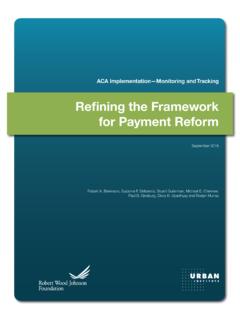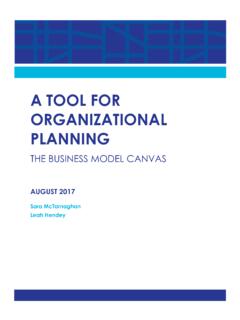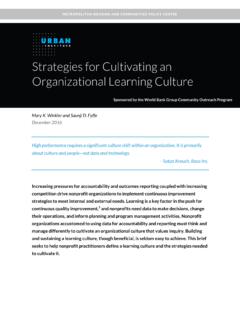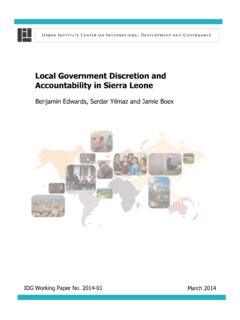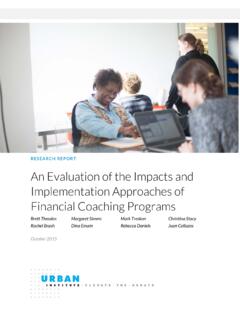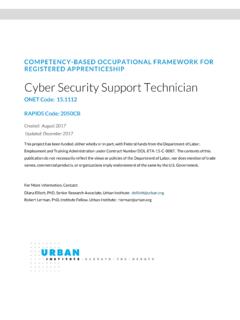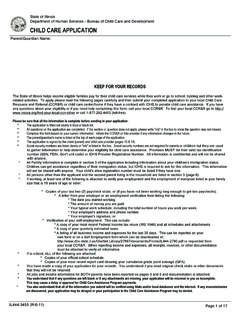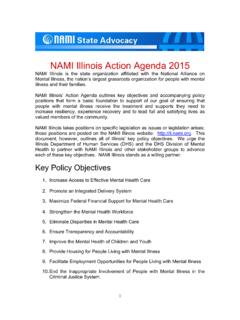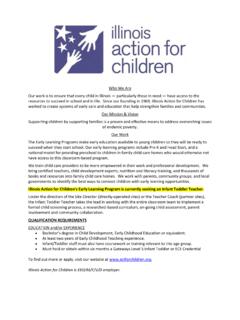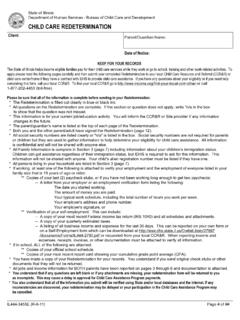Transcription of Mapping Child Care Demand and the Supply of Care for ...
1 R E S E A R C H R E P O R T Mapping Child Care Demand and the Supply of Care for Subsidized Families illinois New York Child Care Research Partnership Heather Sandstrom Amy Claessens Marcia Stoll U R B A N IN S TI TU TE U N IVE R S I TY OF C H I C A G O ILL IN OI S A C TI ON FOR C HI L D RE N Erica Greenberg David Alexander Charmaine Runes U R B A N IN S TI TU TE I L L IN OI S A C TI ON FOR C H I LD RE N U R B A N IN S TI TU TE Julia R. Henly U N IV E R S I TY OF C H I C A GO March 2018 C H I L D R E N A B O U T T H E U R B A N I N S T I T U T E The nonprofit Urban Institute is a leading research organization dedicated to developing evidence-based insights that improve people s lives and strengthen communities. For 50 years, Urban has been the trusted source for rigorous analysis of complex social and economic issues; strategic advice to policymakers, philanthropists, and practitioners; and new, promising ideas that expand opportunities for all.
2 Our work inspires effective decisions that advance fairness and enhance the well-being of people and places. A B O U T T H E U N I V E R S I T Y O F C H I C A G O One of the world's premier academic and research institutions, the University of Chicago has driven new ways of thinking since its 1890 founding. Today, UChicago draws scholars to its Hyde Park and international campuses, keeping UChicago at the nexus of ideas that challenge and change the world. The UChicago community includes students in the undergraduate College and in graduate programs across four divisions, six professional schools including the School of Social Service Administration and the Harris School of Public Policy Studies, and the Graham School of Continuing Liberal Arts and Professional Studies.
3 With a commitment to free and open inquiry, UChicago scholars take an interdisciplinary approach to research and teaching. Their work generates new knowledge for the benefit of present and future generations and transforms the way we understand the world, advancing fields of study, and often creating new ones. A B O U T I L L I N O I S A C T I ON F O R C H I L D R E N As a state and national leader in the early care and education community, illinois action for children stands distinguished by its Strong Families, Powerful Communities approach to Child development, Pre-K and Head Start education, and other family and community supports. We believe that these supports work best to ensure school and life success when administered as part of a comprehensive system that includes parents and communities.
4 This broad approach to supporting children by supporting families is a proven and effective means to address overarching issues of endemic poverty, which is the root cause of the educational failure of America s poorest children . Copyright March 2018. Urban Institute. Permission is granted for reproduction of this file, with attribution to the Urban Institute. Contents Acknowledgments v Executive Summary vii Glossary ix Introduction 1 Methods 5 Estimating Counts of Subsidy-Eligible children 5 Census Tract-Level Data from Public Use Data Tables 5 Public-Use Microdata for Individual-Level Analyses 6 Estimating the Times of Day when Subsidy-Eligible children Need Care 6 Measuring and Mapping Child Care Supply 7 Estimates of Child Care Demand 9 Share of Child Population Potentially Needing Subsidized Care 9 Geographic Distribution of Demand by Study Site 9 Understanding Demand .
5 Low-Income Parents Work Schedules and Related Child Care Needs by Study Site 15 Characteristics of Local Child Care Markets 20 Total Numbers of Providers by Care Type 24 Subsidy Participation 25 Provider Quality 26 Providers Schedules by Care Type 27 Geographic Distribution of Full-Time Providers 31 A Closer Look at Full-Time, Subsidized Care Options: Provider Characteristics and Geographic Distribution 36 Characteristics of Full-Time Providers that Participate in the Subsidy Program 36 Geographic Distribution of Full-Time Providers that Accept Subsidies 40 Locating Subsidized Infant Care 46 Locating High-Quality Subsidized Care 51 Role of Legally Exempt Home-Based Providers 56 Assessment of Unmet Need 58 Summary of Findings 67 Appendix A. Supplemental Maps and Figures 69 Appendix B.
6 Supplemental Tables 81 Notes 87 References 88 About the Authors 89 Statement of Independence 91 A C K N O W L E D G M E N T S V Acknowledgments This report is based on the illinois New York Child Care Research Partnership Study made possible by Grant No. 90YE0151 from the Office of Planning, Research, and Evaluation (OPRE) in the Administration for children and Families, US Department of Health and Human Services. We are grateful to them and to all our funders, who make it possible for Urban to advance its mission. The views expressed are those of the authors and should not be attributed to the Urban Institute, its trustees, its funders, or to the University of Chicago or our partnering organizations. Funders do not determine research findings or the insights and recommendations of Urban experts.
7 Further information on the Urban Institute s funding principles is available at The principal investigator for the illinois New York Child Care Research Partnership Study is Julia Henly from the University of Chicago School of Social Service Administration. Coprincipal investigators are Amy Claessens from the University of Chicago Harris School of Public Policy and Heather Sandstrom from the Urban Institute. David Alexander and Marcia Stoll are researchers at our local partner organization, illinois action for children . The project was supported by an excellent team of analysts and research assistants. We thank Lina Breslav, Molly Michie, and Teresa Derrick-Mills from the Urban Institute for their contributions to the study. The study would not have been possible without the endless support of our state and local partners, including the children s Home + Aid Society Southern Region, illinois action for children , the illinois Department of Human Services, New York State Office of children and Family Services, the Westchester County Department of Social Services and Nassau County Department of Social Services, the Child Care Council of Westchester, and the Child Care Council of Nassau.
8 We are especially grateful for the data we received from the illinois Network of Child Care Resource and Referral Agencies and the support of Joellyn Whitehead. We also thank Erin Hardy for her review of this paper and excellent feedback and our external research advisors, Elizabeth Davis and Roberta Weber, for their review of preliminary findings and ongoing support of the X E C U T I V E S U M M A R Y VII Executive Summary As part of the illinois New York Child Care Research Partnership, this report explores the local Child care markets in two areas in each state: in New York, Nassau and Westchester counties, and in illinois , Cook County and a seven-county region in the southwest part of the state. Our analyses address the following descriptive research questions: 1.
9 How are Child care programs with distinct characteristics distributed in each of the four study sites? 2. How does the Supply of Child care match the heterogeneous needs of subsidy-eligible families? 3. Are there patterns of alignment or misalignment that suggest both needs and opportunities for program development or policy intervention? We examine the potential Demand for subsidized care in these areas using data from the US Census Bureau s American Community Survey, giving particular attention to low-income parents working nonstandard schedules. We also identify neighborhoods with large shares of households with limited English proficiency (LEP) because these families may have additional care needs and preferences. We then use data from Child care resource and referral agencies and state Child care subsidy records to examine the Supply of care available to families in different communities, paying particular attention to the type of care, subsidy program participation, hours of operation, Child age requirements, national accreditation, and participation in the state quality rating and improvement system.
10 A series of maps show the Supply of licensed and registered providers across sectors in the study communities and how local Supply meets the potential need for subsidized Child care. We describe the overall Child care market in our study areas and then position providers who accept Child care subsidies within the broader Child care market. The maps show that many, but not all, of the greatest gaps in coverage are in areas with a high density of subsidy-eligible families. We identify these areas as Child care deserts areas or communities with limited or no access to quality Child care. The local choice set for the typical subsidy-eligible Child does not include centers that are full time, accept subsidies, or are quality rated or accredited. Before accounting for competition with children from higher-income families, it appears that families with a subsidy might be able to find a slot in a full-time program that accepts a subsidy.
